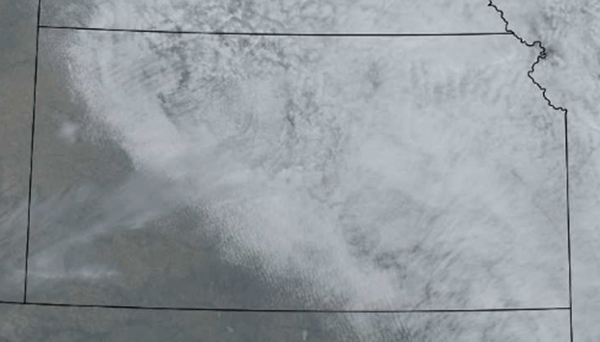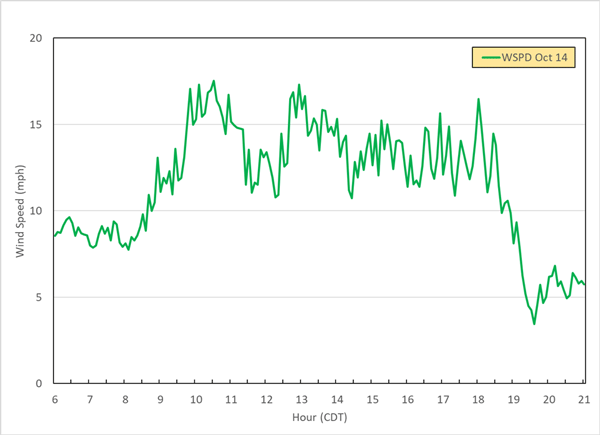On October 14, an infrequent astronomical event took place: a partial solar eclipse. The moon’s orbit passed between Earth and the sun, temporarily blocking Kansas’ view of the entire solar disc for about 3 hours during the late morning and early afternoon hours. At its peak, 60 to 80% of the solar disc was obscured in Kansas, with the lowest percent of coverage in the northeast and the highest in the southwest. Unfortunately, cloud cover obscured a clear view of the eclipse across most of the state (Figure 1). The best views were in the southwest part of the state, where skies were generally clear to partly cloudy. Even where there were clouds, the eclipse was still visible in a meteorological sense. Our Kansas Mesonet sites captured some changes to meteorological variables during the eclipse. In this report, we look at some of the changes to sensible weather that occurred.

Figure 1. Satellite image of Kansas at 1 p.m. CT on October 14, 2023. Source: http://weather.rap.ucar.edu/satellite.
One Mesonet site with little to no cloud cover during the eclipse was the Clark County tower 8 miles south of Ashland, which made it an ideal candidate for examination of its observational data. A plot of solar radiation (Figure 2), measured at 5-minute intervals at Ashland, shows the eclipse resulted in less solar radiation reaching the Mesonet site from roughly 10:30 AM until 1:30 PM, the approximate beginning and end of the eclipse. At 11:50 AM, the solar radiation was only 147 watts per square meter when the eclipse was near its peak. Compared to the following day, one in which the skies were also clear, the eclipse's difference to incoming solar radiation is evident, as 147 was just 22% of the solar radiation from 11:50 AM on the 15th when 665 watts per square meter was measured.
The reduction of incoming solar radiation decreased air temperature at Ashland (Figure 3). The temperature fell from 51.2° F at 10:50 AM to 49.2° F by 11:55 AM, just after the eclipse's peak. The wind speed dropped as well (Figure 4). The average wind speed from 30 minutes before to 30 minutes after the eclipse’s peak was 12.3 mph, compared to 15.8 mph from the preceding hour (90 to 30 minutes before the peak) and 15.2 mph in the following hour (30 to 90 minutes after the peak).

Figure 2. A plot of solar radiation measured by the Ashland Mesonet site on October 14 and 15, 2023.

Figure 3. A plot of air temperature measured by the Ashland Mesonet site on October 14, 2023.

Figure 4. A plot of 10-meter wind speed measured by the Ashland Mesonet site on October 14, 2023.
Interestingly, the effects of incoming solar radiation from the eclipse were also detectable at locations where skies were cloudy. The decrease in solar radiation during the eclipse was smaller in magnitude at cloudy locations like Manhattan (Figure 5), but it was still measurable. However, there were no apparent temperature and wind speed decreases in Manhattan during the eclipse.

Figure 5. A plot of solar radiation measured by the Ashland and Manhattan Mesonet sites on October 14, 2023.
Future solar eclipses in Kansas
If you missed out on witnessing this eclipse, you won’t have to wait long until the next one. Another solar eclipse will occur less than six months from now, on Monday, April 8, 2024 (Figure 6). It will be only a partial eclipse in Kansas, with the percentage of sun obscuration ranging from 71% in the northwest to 96% in the southeast. Unlike the eclipse on October 14, there will be a total eclipse in some parts of the United States. To witness the total eclipse, you’ll need to drive south and east to places like Dallas, Texas, Little Rock, Arkansas, or Cape Girardeau, Missouri. Let’s hope for clear skies that day, for good viewing and data collection during a rare astronomical phenomenon.

Figure 6. The solar eclipse on April 8, 2024, will be partial in the state of Kansas, with a path of totality to the southeast across parts of Texas, Oklahoma, Arkansas, and Missouri. Source: https://www.timeanddate.com/eclipse/map/2024-april-8.
Matthew Sittel, Assistant State Climatologist
msittel@ksu.edu